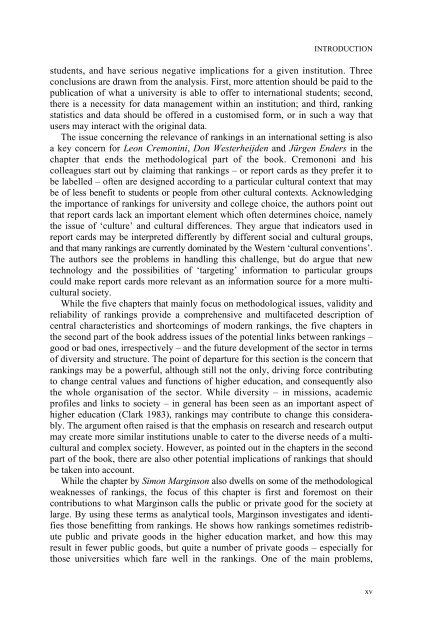University Rankings, Diversity, and the New ... - Sense Publishers
University Rankings, Diversity, and the New ... - Sense Publishers
University Rankings, Diversity, and the New ... - Sense Publishers
You also want an ePaper? Increase the reach of your titles
YUMPU automatically turns print PDFs into web optimized ePapers that Google loves.
INTRODUCTION<br />
students, <strong>and</strong> have serious negative implications for a given institution. Three<br />
conclusions are drawn from <strong>the</strong> analysis. First, more attention should be paid to <strong>the</strong><br />
publication of what a university is able to offer to international students; second,<br />
<strong>the</strong>re is a necessity for data management within an institution; <strong>and</strong> third, ranking<br />
statistics <strong>and</strong> data should be offered in a customised form, or in such a way that<br />
users may interact with <strong>the</strong> original data.<br />
The issue concerning <strong>the</strong> relevance of rankings in an international setting is also<br />
a key concern for Leon Cremonini, Don Westerheijden <strong>and</strong> Jürgen Enders in <strong>the</strong><br />
chapter that ends <strong>the</strong> methodological part of <strong>the</strong> book. Cremononi <strong>and</strong> his<br />
colleagues start out by claiming that rankings – or report cards as <strong>the</strong>y prefer it to<br />
be labelled – often are designed according to a particular cultural context that may<br />
be of less benefit to students or people from o<strong>the</strong>r cultural contexts. Acknowledging<br />
<strong>the</strong> importance of rankings for university <strong>and</strong> college choice, <strong>the</strong> authors point out<br />
that report cards lack an important element which often determines choice, namely<br />
<strong>the</strong> issue of ‘culture’ <strong>and</strong> cultural differences. They argue that indicators used in<br />
report cards may be interpreted differently by different social <strong>and</strong> cultural groups,<br />
<strong>and</strong> that many rankings are currently dominated by <strong>the</strong> Western ‘cultural conventions’.<br />
The authors see <strong>the</strong> problems in h<strong>and</strong>ling this challenge, but do argue that new<br />
technology <strong>and</strong> <strong>the</strong> possibilities of ‘targeting’ information to particular groups<br />
could make report cards more relevant as an information source for a more multicultural<br />
society.<br />
While <strong>the</strong> five chapters that mainly focus on methodological issues, validity <strong>and</strong><br />
reliability of rankings provide a comprehensive <strong>and</strong> multifaceted description of<br />
central characteristics <strong>and</strong> shortcomings of modern rankings, <strong>the</strong> five chapters in<br />
<strong>the</strong> second part of <strong>the</strong> book address issues of <strong>the</strong> potential links between rankings –<br />
good or bad ones, irrespectively – <strong>and</strong> <strong>the</strong> future development of <strong>the</strong> sector in terms<br />
of diversity <strong>and</strong> structure. The point of departure for this section is <strong>the</strong> concern that<br />
rankings may be a powerful, although still not <strong>the</strong> only, driving force contributing<br />
to change central values <strong>and</strong> functions of higher education, <strong>and</strong> consequently also<br />
<strong>the</strong> whole organisation of <strong>the</strong> sector. While diversity – in missions, academic<br />
profiles <strong>and</strong> links to society – in general has been seen as an important aspect of<br />
higher education (Clark 1983), rankings may contribute to change this considerably.<br />
The argument often raised is that <strong>the</strong> emphasis on research <strong>and</strong> research output<br />
may create more similar institutions unable to cater to <strong>the</strong> diverse needs of a multicultural<br />
<strong>and</strong> complex society. However, as pointed out in <strong>the</strong> chapters in <strong>the</strong> second<br />
part of <strong>the</strong> book, <strong>the</strong>re are also o<strong>the</strong>r potential implications of rankings that should<br />
be taken into account.<br />
While <strong>the</strong> chapter by Simon Marginson also dwells on some of <strong>the</strong> methodological<br />
weaknesses of rankings, <strong>the</strong> focus of this chapter is first <strong>and</strong> foremost on <strong>the</strong>ir<br />
contributions to what Marginson calls <strong>the</strong> public or private good for <strong>the</strong> society at<br />
large. By using <strong>the</strong>se terms as analytical tools, Marginson investigates <strong>and</strong> identifies<br />
those benefitting from rankings. He shows how rankings sometimes redistribute<br />
public <strong>and</strong> private goods in <strong>the</strong> higher education market, <strong>and</strong> how this may<br />
result in fewer public goods, but quite a number of private goods – especially for<br />
those universities which fare well in <strong>the</strong> rankings. One of <strong>the</strong> main problems,<br />
xv














